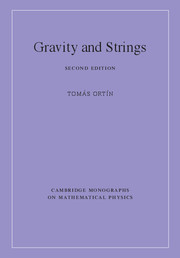Book contents
- Frontmatter
- Dedication
- Contents
- Preface to the second edition
- Preface to the first edition
- Part I Introduction to gravity and supergravity
- 1 Differential geometry
- 2 Symmetries and Noether's theorems
- 3 A perturbative introduction to general relativity
- 4 Action principles for gravity
- 5 Pure N = 1, 2, d = 4 supergravities
- 6 Matter-coupled N = 1, d = 4 supergravity
- 7 Matter-coupled N = 2, d = 4 supergravity
- 8 A generic description of all the N ≥ 2, d = 4 SUEGRAs
- 9 Matter-coupled N = 1, d = 5 supergravity
- 10 Conserved charges in general relativity
- Part II Gravitating Point-Particles
- Part III Gravitating extended objects of string theory
- Appendix A Lie groups, symmetric spaces, and Yang–Mills fields
- Appendix B The irreducible, non-symmetric Riemannian spaces of special holonomy
- Appendix C Miscellanea on the symplectic group
- Appendix D Gamma matrices and spinors
- Appendix E Kähler geometry
- Appendix F Special Kähler geometry
- Appendix G Quaternionic-Kähler geometry
- Appendix H Real special geometry
- Appendix I The generic scalar manifolds of N ≥ 2, d = 4 SUEGRAs
- Appendix J Gauging isometries of non-linear σ-models
- Appendix K n-spheres
- Appendix L Palatini's identity
- Appendix M Conformal rescalings
- Appendix N Connections and curvature components
- Appendix O The harmonic operator on ℝ3 × S1
- References
- Index
3 - A perturbative introduction to general relativity
from Part I - Introduction to gravity and supergravity
Published online by Cambridge University Press: 05 April 2015
- Frontmatter
- Dedication
- Contents
- Preface to the second edition
- Preface to the first edition
- Part I Introduction to gravity and supergravity
- 1 Differential geometry
- 2 Symmetries and Noether's theorems
- 3 A perturbative introduction to general relativity
- 4 Action principles for gravity
- 5 Pure N = 1, 2, d = 4 supergravities
- 6 Matter-coupled N = 1, d = 4 supergravity
- 7 Matter-coupled N = 2, d = 4 supergravity
- 8 A generic description of all the N ≥ 2, d = 4 SUEGRAs
- 9 Matter-coupled N = 1, d = 5 supergravity
- 10 Conserved charges in general relativity
- Part II Gravitating Point-Particles
- Part III Gravitating extended objects of string theory
- Appendix A Lie groups, symmetric spaces, and Yang–Mills fields
- Appendix B The irreducible, non-symmetric Riemannian spaces of special holonomy
- Appendix C Miscellanea on the symplectic group
- Appendix D Gamma matrices and spinors
- Appendix E Kähler geometry
- Appendix F Special Kähler geometry
- Appendix G Quaternionic-Kähler geometry
- Appendix H Real special geometry
- Appendix I The generic scalar manifolds of N ≥ 2, d = 4 SUEGRAs
- Appendix J Gauging isometries of non-linear σ-models
- Appendix K n-spheres
- Appendix L Palatini's identity
- Appendix M Conformal rescalings
- Appendix N Connections and curvature components
- Appendix O The harmonic operator on ℝ3 × S1
- References
- Index
Summary
The standard approach to general relativity (GR) is purely geometrical: spacetime is curved by its energy content according to Einstein's equation and test particles move along geodesics. This point of view is what makes GR a theory completely different from the theories that describe all the other known interactions that are special-relativistic field theories (SRFTs) that, after quantization, explain the interaction between two charged bodies as the interchange of quanta of the field.
The enormous success of relativistic quantum field theories with a gauge principle made it unavoidable to try to find a theory of that kind to describe gravitational interactions at both the classical and quantum levels. This path was followed by many people, and it was found that such a theory, whose starting point is the linear perturbation theory of GR (the Fierz–Pauli theory for a free, massless spin-2 particle), would be self-consistent only after the introduction of an infinite number of non-linear terms whose summation should be equivalent to the full non-linear GR theory. Thus, this approach may lead to a different justification of Einstein's theory and provides an alternative interpretation of it that is worth studying. Some of the predictions of GR can be obtained at leading or next to leading order in this approach. Since this is not the standard approach, there are only a few complete treatments in the literature: the book based on Feynman's lectures on gravitation [542], which also contains many references, some of which we will follow in Section 3.2; and also Deser's lectures on the gravitational field [431]. Reference [32] is also an excellent review with many references.
In this chapter, as a warm-up exercise, we are first going to study the construction of SRFTs of gravity based on a scalar field. This is the simplest way of searching for a SRFT of gravitational interaction, and it offers us the possibility of studying, in a simple setting, problems that we shall meet later.
Information
- Type
- Chapter
- Information
- Gravity and Strings , pp. 70 - 138Publisher: Cambridge University PressPrint publication year: 2015
